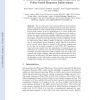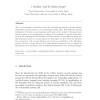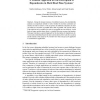194 search results - page 16 / 39 » Formal concept analysis applied to fault localization |
DIMVA
2009
13 years 9 months ago
2009
The use of dynamic access control policies for threat response adapts local response decisions to high level system constraints. However, security policies are often carefully tigh...
ISCI
2010
13 years 6 months ago
2010
The t-concept lattice is introduced as a set of triples associated to graded tabular information interpreted in a non-commutative fuzzy logic. Following the general techniques of ...
ICCCN
2008
IEEE
14 years 2 months ago
2008
IEEE
— Centrality is a concept often used in social network analysis to study different properties of networks that are modeled as graphs. We present a new centrality metric called Lo...
ISOLA
2010
Springer
13 years 6 months ago
2010
Springer
During the design iterations of embedded systems, the schedulability analysis is an important method to verify whether the real-time constraints are satisfied. In order to achieve...
EVOW
2010
Springer
14 years 2 months ago
2010
Springer
Abstract. The fitness distance correlation (FDC) as a measure for problem difficulty was first introduced by Forrest and Jones. It was applied to many binary coded problems. This...



